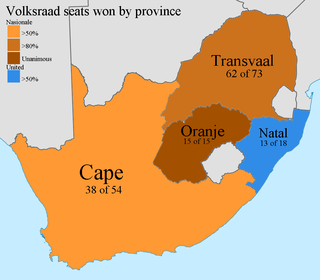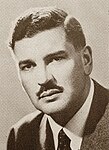Elections in South Africa are held for the National Assembly, National Council of Provinces, provincial legislatures and municipal councils. Elections follow every 2 to 3 years with General Elections and Municipal Elections. The electoral system is based on party-list proportional representation, which means that parties are represented in proportion to their electoral support. For municipal councils there is a mixed-member system in which wards elect individual councillors alongside those named from party lists.

General elections were held in South Africa on 15 September 1910 to elect the 121 members of the House of Assembly. They were the first general election after the Union of South Africa was created on 31 May 1910.

General elections were held in South Africa on 18 October 1961. They were the first general elections after South Africa became a republic following the 1960 South African referendum. The National Party under H. F. Verwoerd won a majority in the House of Assembly.

General elections were held in South Africa on 15 April 1953. The elections consolidated the position of the National Party under D. F. Malan, which won an absolute majority of the 156 elected seats in the House of Assembly, also receiving the most votes. Its first-time majority of the white electorate would be retained until the 1989 elections.

General elections were held in South Africa on 30 March 1966. The result was another comprehensive victory for the National Party under H. F. Verwoerd.

General elections were held in South Africa on 18 May 1938 to elect the 150 members of the House of Assembly. The United Party won an absolute majority.

General elections were held in South Africa on 7 July 1943 to elect the 150 members of the House of Assembly. The United Party of Jan Smuts won an absolute majority.

The House of Assembly was the lower house of the Parliament of South Africa from 1910 to 1981, the sole parliamentary chamber between 1981 and 1984, and latterly the white representative house of the Tricameral Parliament from 1984 to 1994, when it was replaced by the current National Assembly. Throughout its history, it was exclusively constituted of white members who were elected to office predominantly by white citizens, though until 1960 and 1970, respectively, some Black Africans and Coloureds in the Cape Province voted under a restricted form of suffrage.
The Cape Provincial Council was the provincial council of the Cape Province of South Africa. It was created by the South Africa Act 1909, with effect from the formation of the Union of South Africa on 31 May 1910. The first election to the provincial council took place on 15 September 1910.

Albany was a constituency in the Cape Province of South Africa, which existed from 1910 to 1994. It was named after the district of Albany, which covered parts of today's Eastern Cape province, and its main population centre was Grahamstown. Throughout this time it elected one member to the House of Assembly and one to the Cape Provincial Council.

Cape Town Castle was a constituency in the Cape Province of South Africa, which existed from 1910 to 1958. Named after the Castle of Good Hope, it covered an area north of Table Mountain and east of the Cape Town CBD. Throughout its existence it elected one member to the House of Assembly and one to the Cape Provincial Council.
Fort Beaufort was a constituency in the Cape Province of South Africa, which existed from 1910 to 1966. Named after the town of Fort Beaufort, the seat covered a rural area in the centre of the Eastern Cape. Throughout its existence it elected one member to the House of Assembly and one to the Cape Provincial Council.

Cape Town Central was a constituency in the Cape Province of South Africa, which existed from 1910 to 1943. It covered the central business district of Cape Town. Throughout its existence it elected one member to the House of Assembly and one to the Cape Provincial Council.

Cape Town Harbour was a constituency in the Cape Province of South Africa, which existed from 1910 to 1929. It covered an area along the coast of Cape Town, including parts of the CBD as well as the Sea Point area. Throughout its existence it elected one member to the House of Assembly and one to the Cape Provincial Council.

Algoa was a constituency in the Cape Province of South Africa, which existed from 1966 to 1994. Named after Algoa Bay, which forms the natural harbour of Port Elizabeth, it covered Port Elizabeth's northwestern suburbs. Despite its name, the constituency was landlocked for most of its existence, with the actual Algoa Bay coastline mostly forming part of the neighbouring seat of Port Elizabeth North. Throughout its existence it elected one member to the House of Assembly and one to the Cape Provincial Council.

Port Elizabeth North was a constituency in the Cape Province of South Africa, which existed from 1929 to 1994. As the name indicates, the seat covered the northern suburbs of Port Elizabeth. Throughout its existence it elected one member to the House of Assembly and one to the Cape Provincial Council.

Newton Park was a constituency in the Cape Province of South Africa, which existed from 1966 to 1994. It covered the western suburbs of Port Elizabeth, centred on its namesake suburb of Newton Park. Throughout its existence it elected one member to the House of Assembly and one to the Cape Provincial Council.

Walmer was a constituency in the Cape Province of South Africa, which existed from 1966 to 1994. It covered the southern suburbs of Port Elizabeth, centred on its namesake suburb of Walmer. Throughout its existence it elected one member to the House of Assembly and one to the Cape Provincial Council.

Port Elizabeth Central was a constituency in the Cape Province of South Africa, which existed from 1910 to 1994. As the name indicates, the seat covered the central area of Port Elizabeth. Throughout its existence it elected one member to the House of Assembly and one to the Cape Provincial Council.

Bellville was a constituency in the Cape Province of South Africa, which existed from 1933 to 1938 and again from 1953 to 1994. It was centred on the railway junction of Bellville, and covered various areas of Cape Town’s eastern suburbs. Throughout its existence it elected one member to the House of Assembly and one to the Cape Provincial Council.





















